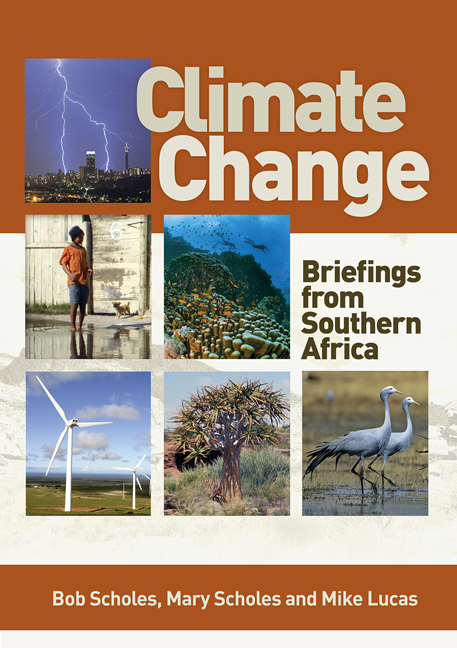Book contents
- Frontmatter
- Acknowledgements
- Contents
- Foreword
- Acronyms and abbreviations
- Preface
- How do governments assess climate change?
- Section 1 Earth system science: The processes that underlie climate change
- Introduction
- 1 Why is Earth habitable?
- 2 How do greenhouse gases regulate Earth's temperature?
- 3 Is water vapour the most important greenhouse gas?
- 4 Why are clouds the wild card in climate change?
- 5 Is climate change just part of a long-term natural cycle?
- 6 Are climate variations just due to volcanoes or other Earth processes?
- 7 How do El Niño and La Niña events affect South African weather?
- 8 How hot might it get in South Africa this century?
- 9 How might the rainfall in Southern Africa change in the twenty-first century?
- 10 Are extreme weather events related to climate change?
- 11 How do land-use changes and deforestation affect global warming?
- 12 What is South Africa's contribution to global warming?
- 13 What happens to carbon dioxide emissions?
- 14 Can ecosystems keep sucking up carbon dioxide from fossil fuel burning?
- 15 Could ocean currents slow down or change direction?
- 16 Is there any chance of runaway global warming?
- Section 2 Consequences of a changing climate for the Southern African environment
- Section 3 Consequences of a changing climate for society
- Section 4 What we can do to avoid and adapt to climate change
- Codicil Is there a dangerous level of climate change?
- Glossary
- List of figures
- References
- Reading list
- Index
14 - Can ecosystems keep sucking up carbon dioxide from fossil fuel burning?
from Section 1 - Earth system science: The processes that underlie climate change
Published online by Cambridge University Press: 20 April 2018
- Frontmatter
- Acknowledgements
- Contents
- Foreword
- Acronyms and abbreviations
- Preface
- How do governments assess climate change?
- Section 1 Earth system science: The processes that underlie climate change
- Introduction
- 1 Why is Earth habitable?
- 2 How do greenhouse gases regulate Earth's temperature?
- 3 Is water vapour the most important greenhouse gas?
- 4 Why are clouds the wild card in climate change?
- 5 Is climate change just part of a long-term natural cycle?
- 6 Are climate variations just due to volcanoes or other Earth processes?
- 7 How do El Niño and La Niña events affect South African weather?
- 8 How hot might it get in South Africa this century?
- 9 How might the rainfall in Southern Africa change in the twenty-first century?
- 10 Are extreme weather events related to climate change?
- 11 How do land-use changes and deforestation affect global warming?
- 12 What is South Africa's contribution to global warming?
- 13 What happens to carbon dioxide emissions?
- 14 Can ecosystems keep sucking up carbon dioxide from fossil fuel burning?
- 15 Could ocean currents slow down or change direction?
- 16 Is there any chance of runaway global warming?
- Section 2 Consequences of a changing climate for the Southern African environment
- Section 3 Consequences of a changing climate for society
- Section 4 What we can do to avoid and adapt to climate change
- Codicil Is there a dangerous level of climate change?
- Glossary
- List of figures
- References
- Reading list
- Index
Summary
The uptake of carbon dioxide (CO2) by land ecosystems will decline this century. Marine ecosystems will remain sinks for CO2, but will suffer acidification as a consequence.
At present, Earth's biosphere of land, freshwater and ocean ecosystems reabsorbs just over half of all human-created CO2 emissions. This annual uptake of around 5.5 billion tonnes of carbon (20 billion tonnes CO2) is just 2.7% of the nearly 200 billion tonnes of natural annual carbon exchange between the biosphere and atmosphere, and so is easy to miss. Furthermore, it cannot continue indefinitely. The natural carbon cycle is finely balanced between uptake and release, so even a small increase in uptake means that the carbon has to accumulate somewhere in the biosphere. This accumulation either has limits, as on land, or strongly negative consequences, as in the ocean.
At present, the biospheric CO2 sink is almost equally split between land and ocean, with a very small freshwater sink due to lakes, rivers and marshes. On land, the carbon is mostly in the form of humus and small fragments of dead plants and animals in soil, or wood in trees. The quantity of woody biomass that can accumulate on any piece of land has an upper limit, mostly determined by the climate. There is only so much tree cover that can be supported for a given amount of rainfall, fire and windstorm frequency, and the height of the trees is limited by the physics of water transport and structural strength. The bigger the tree, the more it respires – so eventually a balance is reached between photosynthesis and respiration. This is called a climax forest. Paradoxically, the ecosystems that are best for taking up carbon are the young ones recovering from disturbance, not the old ones which are nearly carbon neutral. Biomass carbon can be lost suddenly, especially as a result of fire, windstorms or pest outbreaks. These disturbances are becoming increasingly frequent as a result of climate change.
Soils also have an upper carbon storage limit, determined by their depth, clay content and degree of waterlogging. As the temperature and size of the organic carbon store in an ecosystem rise, so does the rate at which the ecosystem releases CO2 through microbial respiration.
- Type
- Chapter
- Information
- Climate ChangeBriefings from Southern Africa, pp. 41 - 43Publisher: Wits University PressPrint publication year: 2015



